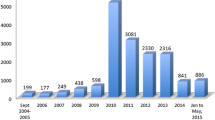Abstract
Pharmacovigilance in South Africa was formalised in 1987 with the creation of the first pharmacovigilance centre in Africa. This pharmacovigilance centre subsequently became a full member of the World Health Organization (WHO) Collaborating Centre for International Drug Monitoring in 1992. In 2004, pharmacovigilance received a major boost with the roll-out of the South Africa antiretroviral treatment (ART) programme and the establishment of a National Pharmacovigilance Centre for Public Health Programmes (NPC) within the National Department of Health (NDOH). The NPC’s activities maintain a special focus on public health pharmacovigilance, monitoring patient safety in important treatment programmes such as TB, HIV and others. In comparison, pharmacovigilance, assessing the risk–benefit profile of registered medical products in both the pre- and post-approval periods, continues to be conducted by the Medicines Control Council (MCC). This article provides past, current and future perspectives of pharmacovigilance in the South African public health programmes. These were informed by the review of published articles, international and regional reports, health law and policy documents, as well as strategic plans and reports from within the South African NDOH. South Africa now understands that the benefit–harm ratio of medicines is a dynamic variable that has to be monitored continuously. Reconceptualising the pharmacovigilance system in South Africa to focus on treatment programmes and individual patients has gradually set the stage for a holistic system and established a decentralised but structured and highly participative national pharmacovigilance programme that significantly benefits public health and patient care.




Similar content being viewed by others
References
WHO Policy Perspectives on Medicines. Pharmacovigilance: ensuring the safe use of medicines. 2004. http://www.whqlibdoc.who.int/hq/2004/WHO_EDM_2004.8.pdf. Accessed 2 Dec 2015.
Harmark L, van Grootheest AC. Pharmacovigilance: methods, recent developments and future perspectives. Eur J Clin Pharmacol. 2008;64(8):743–52.
Jeetu G, Anusha G. Pharmacovigilance: a worldwide master key for drug safety monitoring. J Young Pharm. 2010;2(3):315–20.
Dheda M. Decentralized HIV/AIDS pharmacovigilance in South Africa: Mpumalanga as pilot province for national roll-out. J AIDS HIV Res. 2013;5(9):357–65.
Dheda M, Distefano K, Sunduzwayo K, Williams F, Kambafwile H. Decentralized HIV/AIDS pharmacovigilance in South Africa: Mpumalanga success and moving forward. J AIDS HIV Res. 2013;5(9):370–9.
South African National Department of Health. Reporting of post-marketing adverse drug reactions to human medicinal products in South Africa. Guideline 2.11 Version 1.0. 2003.
Strengthening Pharmaceutical Systems (SPS) Program. Safety of medicines in Sub-Saharan Africa: assessment of pharmacovigilance systems and their performance. Submitted to the US Agency for International Development by the Strengthening Pharmaceutical Systems (SPS) Program. Arlington: Management Sciences for Health; 2011.
Essack SY, Schellack N, Pople T, van der Merwe L, Suleman F, Meyer JC, Gous AG, Benjamin D. Antibiotic supply chain and management in human health. S Afr Med J. 2011;101:562–6.
Uppsala Monitoring Centre. The WHO Programme. Introduction to the WHO Programme for International Drug Monitoring. 2015. http://www.who-umc.org/DynPage.aspx?id=98080&mn1=7347&mn2=7252&mn3=7322. Accessed 2 Dec 2015.
Sanctions Against South Africa Lifted. In: CQ Almanac 1991, 47th edn. Washington, DC: Congressional Quarterly; 1992. p. 478–79. http://library.cqpress.com/cqalmanac/cqal91-1111124. Accessed 2 Dec 2015.
Uppsala Monitoring Centre. WHO Programme members. http://www.who-umc.org/DynPage.aspx?id=100653&mn1=7347&mn2=7252&mn3=7322&mn4=7442. Accessed 9 May 2016.
South African National Department of Health. Reporting of post-marketing adverse drug reactions to human medicinal products in South Africa. Guideline 2.33 Version 1.0. 2003.
South African National Department of Health. Operational plan for comprehensive HIV and AIDS care, management and treatment for South Africa. Department of Health 2012/13 Annual Report; 2003. RP: 237/2012 ISBN: 978-0-621-41127-0.
Department of Health. National antenatal sentinel HIV and syphilis prevalence survey in South Africa 2011 report. South Africa: Department of Health; 2011.
South African National Department of health strategic plan 2014/15–2018/19, RP: 37/2014. ISBN: 978-0-621-42474-4.
Decentralized HIV/AIDS and TB pharmacovigilance in South Africa: Mpumalanga province success and moving forward. Submitted to the South African NDoH, Pretoria, South Africa.
National Pharmacovigilance Centre. August 2014, Decentralized Pharmacovigilance Report for Northwest Province.
Mehta U, Dheda M, Steel G, Blockman M, Ntilivamunda A, Maartens G, Pillay Y, Cohen K. Strengthening Pharmacovigilance in South Africa. S Afr Med J. 2014;104:104–6.
The Erice declaration. On communicating drug safety information. Prescrire Int. 1998;7:191.
The European Parliament and the Council of the European Union. Directive 2004/27/EC of the European Parliament and of the Council of 31 March 2004 amending Directive 2001/83/EC on the Community code relating to medicinal products for human use. Off J Eur Union. 2004;2004(L136):34–57.
Acknowledgments
The author would like to acknowledge all the healthcare providers and administrators who have contributed to the successful evolution of the pharmacovigilance field in South Africa, and in particular to the success of decentralised pharmacovigilance as the new approach to managing ADRs in patients.
Author information
Authors and Affiliations
Corresponding author
Ethics declarations
Funding
This work was not funded.
Conflict of interest
Mukesh Dheda is the Director of the National Pharmacovigilance Centre for Public Health Programmes based at the National Department of Health in South Africa.
Rights and permissions
About this article
Cite this article
Dheda, M. Perspectives on the Emergence of Pharmacovigilance in Public Health Programmes in South Africa. Pharm Med 30, 213–219 (2016). https://doi.org/10.1007/s40290-016-0150-x
Published:
Issue Date:
DOI: https://doi.org/10.1007/s40290-016-0150-x




